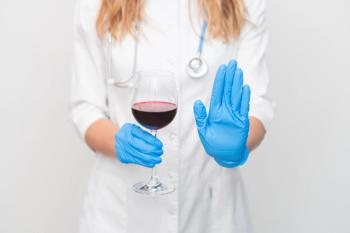
- Vol 30 No 6
- Volume 30
- Issue 6
“PRN” Medication for Alcohol Dependence May Reduce Harm
In a new study, "as needed" use of an opioid antagonist for heightened alcohol craving appeared to reduce the number of heavy drinking days and total amount of alcohol consumed.
[[{"type":"media","view_mode":"media_crop","fid":"13936","attributes":{"alt":"","class":"media-image media-image-right","id":"media_crop_2129521641715","media_crop_h":"0","media_crop_image_style":"-1","media_crop_instance":"656","media_crop_rotate":"0","media_crop_scale_h":"175","media_crop_scale_w":"160","media_crop_w":"0","media_crop_x":"0","media_crop_y":"0","style":"margin: 1px; float: right;","title":" ","typeof":"foaf:Image"}}]]In the largest controlled study to date of an “as-needed” medication treatment modality, prn use of an opioid antagonist for heightened alcohol craving appeared to reduce the number of heavy drinking days and total amount of alcohol consumed.
Karl Mann, MD, PhD, and associates at the University of Heidelberg reported their findings in the April 2013 issue of Biological Psychiatry. They commented that the treatment paradigm could address an unmet medical need, “because it . . . has the potential to engage patients at risk of alcohol-related harm who might otherwise not have sought help.”1
In an accompanying commentary, Robert Swift, MD, PhD, of Brown University, observed that the goal of reduction rather than abstinence remains controversial.2 Many-including Alcoholics Anonymous-consider abstinence to be the only viable treatment outcome. Still others seek harm reduction from reduced alcohol consumption as a more realistic goal.2
There is benefit, however, in whichever goal can be attained, Swift points out. “Evidence suggests that both abstinence and low-risk alcohol drinking outcomes during treatment predict decreased drinking and reduced alcohol problems more than a year after treatment ends.”
Novel compound taken as needed
The study by Mann and colleagues is at once the largest controlled trial of an “as-needed” medication regimen for alcohol dependence and the largest double-blind placebo-controlled assessment of nalmefene-a compound similar to naltrexone (ReVia). Nalmefene is not yet available in the US. These opioid antagonists are thought to interfere with the reinforcing effects of alcohol mediated by opioid receptor systems. Naltrexone is an antagonist at the μ-, κ-, and δ-opioid receptors. Nalmefene is an antagonist at the μ receptor and a partial agonist at the κ site.
Swift notes that the κ-opioid receptor has been associated with the dysphoria and anxiety in chronic alcohol dependence and withdrawal. He acknowledges, however, that “it is not known whether this difference in κ-opioid receptor activity between the two drugs is reflected in differences in their efficacy in reducing drinking or in differences in side effects.” Naltrexone-but not nalmefene-has the potential to be hepatotoxic.
The study was conducted with more than 600 patients at 39 sites in Austria, Finland, Germany, and Sweden. Patients were randomized to receive 6 months of treatment with placebo or nalmefene, 18 mg/d. “They perceived a risk of drinking alcohol . . . preferably 1 to 2 hours before anticipated time of drinking.”1
In addition to the medication or placebo, all patients participated in a psychosocial therapeutic regimen (acronym, BRENDA3).
Swift noted that this study, like similarly structured studies with naltrexone, demonstrated a substantial effect from participation in either the active or the placebo group. There was an incremental difference, leaving a relatively small but statistically significant advantage of medication over placebo.
The population in the current study had an average of 20 heavy drinking days and 85 g/d of alcohol during the pre-study month. A reduction was apparent in the period between screening and randomization. In month 6 of treatment, the number of mean heavy drinking days was reduced to 8 in those taking nalmefene and to 11 in placebo recipients. The mean daily amount of alcohol was reduced to 33 g with nalmefene and to 45 g with placebo.
Mann and colleagues argue that the differences between groups are clinically relevant as well as statistically significant. They noted that “evidence from epidemiological data shows that every heavy drink-ing day carries an increased risk of accidents, aggression, suicide, and cardiac arrest.”
Swift elaborated on the merit of the “as-needed,” or “targeted,” regimen, which has also been demonstrated with naltrexone. He noted that “both medications can permit the patient to take charge of his or her own treatment and to use medication as a strategy to avoid or to limit alcohol consumption during self-identified high-risk situations.”
References:
1. Mann K, Bladström A, Torup L, et al. Extending the treatment options in alcohol dependence: a randomized controlled study of as-needed nalmefene. Biol Psychiatry. 2013;73:706-713.
2. Swift RM. Naltrexone and nalmefene: any meaningful difference? Biol Psychiatry. 2013;73:700-701.
3. Starosta AN, Leeman RF, Volpicelli JR. The BRENDA model: integrating psychosocial treatment and pharmacotherapy for the treatment of alcohol use disorders. J Psychiatr Pract. 2006;12:80-89.
Articles in this issue
over 12 years ago
The Family Guide to Mental Health Careover 12 years ago
No Mortality Increase With Antipsychotics in Prospective Studyover 12 years ago
Epidemiology and Treatment of Substance Use and Abuse in Adolescentsover 12 years ago
Bias Against Schizophrenic Patients Seeking Medical Careover 12 years ago
Pain and Suicideover 12 years ago
Shared Risk Factors in Multiple Psychiatric Disordersover 12 years ago
Genetics and Pharmacogenetics of Schizophrenia: Recent ProgressNewsletter
Receive trusted psychiatric news, expert analysis, and clinical insights — subscribe today to support your practice and your patients.















